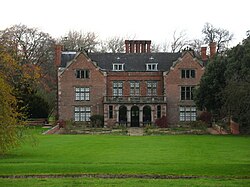Thrumpton Hall
| Thrumpton Hall | |
| Nottinghamshire | |
|---|---|
 Thrumpton Hall | |
| Location | |
| Grid reference: | SK50733126 |
| Location: | 52°52’35"N, 1°14’51"W |
| Village: | Thrumpton |
| History | |
| Built 1617 | |
| For: | Gervase Pigot |
| Country house | |
| Information | |
| Owned by: | Miranda Seymour |
| Website: | thrumptonhall.com |
Thrumpton Hall is a country house in the village of Thrumpton in Nottinghamshire, just south-west of Nottingham.
The hall is a private house. It operated as a wedding venue until November 2020.[1] The hall is a Grade I listed building.[2]
History


This historic house incorporates a substantial part of an older house which was occupied by the Roman Catholic Powdrell family: their estates were forfeit however after the Babington Plot.[3]
The main part of the Hall dates from the early part of the seventeenth century[4] and was built by the Pigot family in rose-coloured brick.[5] it was largely complete by 1617.[6]
In the 1660s the house was altered and improved by his son Gervase Pigot. There were late eighteenth century alterations made for John Wescomb Emerton, further changes c.1830 for John Emerton Wescomb. Later, it passed into the hands of the Byron family for a hundred years; Byron's daughter, Ada, visited her relations at the Hall from her mother's home at Kirkby Mallory, and during visits to Newstead Abbey, which had passed out of Byron ownership.
In 1994, George Fitzroy Seymour (the son of Lady Byron's sister Lady Victoria Seymour (née FitzRoy) and a member of the family of the Marquess of Hertford), passed away and the house was inherited by Miranda Seymour, the novelist and biographer.
Features
It contains a library, a mediæval kitchen, a double cube reception room, baronial hall, and a priest hole. It also hosts a collection of portraits, furniture and needlework, as well as various relics of the poet Lord Byron, whose descendants lived at Thrumpton.
Thrumpton Hall is renowned for its cantilever Jacobean staircase, carved in wood from the estate. This was added to the earlier house by the Pigot family, and shows their coat of arms and that of the former Powdrell owners. The staircase was supervised by John Webb, a pupil of Inigo Jones.
Outside links
| ("Wikimedia Commons" has material about Thrumpton Hall) |
References
- ↑ "Thrumpton Hall". http://thrumptonhall.com/. Retrieved 26 August 2020.
- ↑ National Heritage List 1242464: Thrumpton Hall and attached range of outbuildings (Grade I listing)
- ↑ Country Life 21 May 1959.
- ↑ Paterson's Roads. Daniel Paterson. 1822
- ↑ English country houses open to the public, Christopher Hussey. 1957
- ↑ English Heritage listing information
